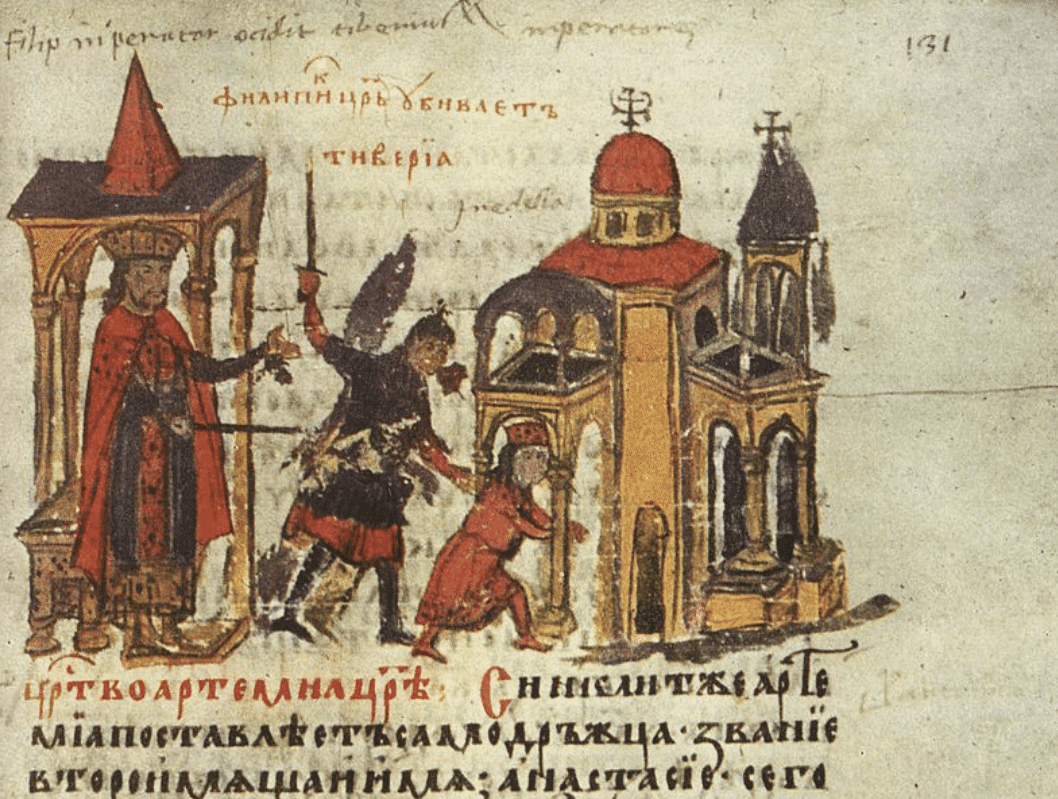20 Years of Anarchy: The Darkest Hour of the Byzantine Empire
Source: GreekReporter.com

Have you ever thought modern politics feels like a rollercoaster with incredible machinations, sharp ups and downs similar to those of Byzantium? Well, strap yourself in and spare a thought for the people living in Constantinople around the turn of the 8th century. For roughly two decades—yes, approximately twenty years. The Byzantine Empire went through a period so chaotic and utterly unstable that historians decided to call it the “Twenty Years’ Anarchy.”
Stable governance was a thing of the past. Simply keeping track of who the emperor was was a challenge, as rulers for the Eastern Roman Empire were changed more often than seasonal decorations. Bear in mind that this was usually conducted in extremely violent ways, too. It is amazing how the whole Empire didn’t just collapse into dust following this relatively unknown, chaotic period.
How the Twenty Years of Anarchy unfolded in the Byzantine Empire
So, how did it all go so wrong? It all started around 695 AD with Emperor Justinian II. Now, Justinian was ambitious, no doubt about it, but he also tended to rub people the wrong way with brutal policies and sky-high taxes that would finance his unpopular choices. Predictably, he got booted off the throne following years of unpopular decisions.

But this wasn’t just an impeachment like any other; the new Emperor who succeeded Justinian, Leontios, had Justinian’s nose cut off—yes, literally he chopped his nose, a particularly charming Byzantine method meant to disqualify him from ever ruling again. You would think that would be the end of it, right? In true Byzantine fashion, it wasn’t. Justinian was then sent into exile in distant Crimea, but this act of violence didn’t bring peace to the capital. Instead, it was like pulling a loose thread that unravelled the imperial garment for twenty years.

What followed was less of a stable succession and more of a dizzying, often bloody, civil confrontation. Leontios lasted only three years before another ambitious man, Tiberios III, overthrew him. Tiberios ruled the Empire for about seven years—an impressive duration in this era of instability—before the unthinkable happened.

Remember Justinian? The one without the nose? It turns out he wasn’t the type of politician to let a little disfigurement on his face stop him. He escaped exile, somehow managed to cut a deal with the powerful Bulgars looming on the northern side of the Empire, and stormed back into Constantinople in 705 to reclaim his throne. Justinian was successful, and his second reign, fueled by bitterness and revenge, was notoriously savage. However, living by the sword often means dying by it, and another revolt in 711 finally ended his story for good. It is difficult to imagine the sheer confusion that Byzantine society experienced at that time.

After Justinian II’s second fall came Philippikos Bardanes, who decided the middle of an existential crisis was the perfect time to reignite complex religious debates. He was followed by Anastasios II, who tried to steady the ship and prepare for the looming Arab threat, only to be ousted by mutinous troops.
They then dragged a reluctant tax collector named Theodosios III onto the throne. Seven emperors in about 22 years. A little more than 3 years each, on average. The constant backstabbing and turmoil gutted the central government, paralysed the once-mighty army, and left the average citizen wondering who was in charge from one week to the next. This was the Empire seemingly trying to tear itself apart.
Surviving the Twenty Years of Anarchy thanks to Leo III
Meanwhile, outside the palace walls, the real world’s threats didn’t pause. The Umayyad Caliphate, Byzantium’s most formidable rival, saw the chaos in Constantinople as a golden opportunity. They had already seized Byzantine North Africa and were now gathering their forces for the final blow—a massive land and sea attack aimed directly at Constantinople, hoping to conquer the center of Christendom. And honestly, who could blame them? The Empire looked ripe for the taking. By 717, the situation was beyond desperate. The Arab enemies were arriving, Theodosios III was clearly not up to the task, and the end seemed nigh.
Then, seemingly out of nowhere, a capable general named Leo the Isaurian marched on the capital. He wasn’t interested in petty politics and drama; he saw the real danger. He persuaded Theodosios III to step aside (probably didn’t take much convincing) and grabbed the reins just as the Arab siege began. What followed was legendary.
Leo III’s determined leadership, the city’s formidable walls, the secret terror weapon known as Greek Fire, and a rare rough winter combined to smash the Arab siege and save Constantinople from their hands. It was a stunning victory against overwhelming odds. More than just saving the city, Leo III slammed the brakes on the anarchy, founded a new, stable dynasty (the Isaurians), and gave the battered Empire the breathing room needed to survive and recover.

Looking back at the Twenty Years’ Anarchy feels like peering into a historical abyss. It shows us how easily internal divisions can cripple a state, leaving it wide open to external threats—a lesson that feels relevant no matter the century.
This is also a story of incredible resilience. The fact that Byzantium did not collapse and could withstand such a prolonged internal nightmare while still fending off an existential attack speaks volumes about its underlying strengths. Leo III’s arrival highlights how crucial decisive leadership can be in pulling things back from the brink. This chaotic, terrifying chapter is a vital, often overlooked part of the long and complex story of the Eastern Roman world.
The original article: belongs to GreekReporter.com .
